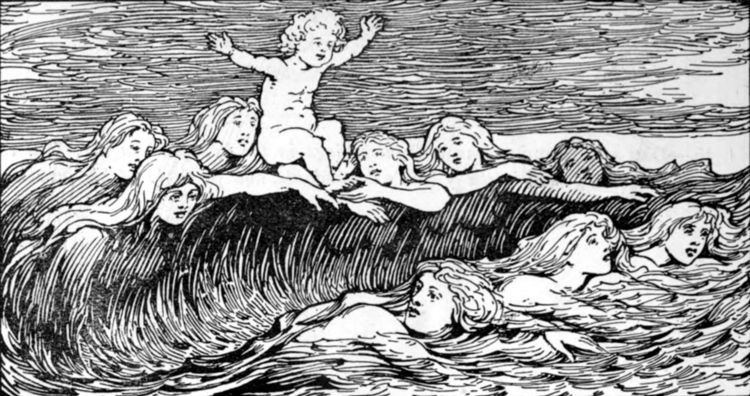 | ||
In Norse mythology, the Nine Mothers of Heimdallr are nine sisters who gave birth to the god Heimdallr. The Nine Mothers of Heimdallr are attested in the Prose Edda, written in the 13th century by Snorri Sturluson; in the poetry of skalds; and possibly also in a poem in the Poetic Edda, a book of poetry compiled in the 13th century from earlier traditional material. Scholars have debated what being "born of nine mothers" implies and have sought to connect the notion to other European folk motifs.
Contents
Attestations
The Nine Mothers of Heimdallr are mentioned in two books of the Prose Edda; Gylfaginning and Skáldskaparmál. In Gylfaginning, Heimdallr is introduced in chapter 25, where the enthroned figure of High tells the disguised mythical king Gangleri details about the god. Among other details, High says that Heimdallr is the son of nine sisters and, as a reference, provides two lines of the (otherwise now lost) poem Heimdalargaldr, in which Heimdallr himself says that he was born of nine sisters.
In chapter 16 of Skáldskaparmál a work by the 10th century skald Úlfr Uggason is quoted. The poem refers to Heimdallr as the "son of eight mothers plus one". Prose following the poem points out that the poem refers to Heimdallr as the son of nine mothers.
The poem Völuspá hin skamma (contained within the poem Hyndluljóð, oft considered a part of the Poetic Edda) contains three stanza that scholars have frequently theorized as referring to Heimdallr and his nine mothers. According to the stanzas, long ago, a mighty god was born by nine jötunn maidens at the edge of the world. This boy grew strong, nourished by the strength of the earth, the ice-cold sea, and the blood of swine. Names are provided for these nine maidens; Gjálp, Greip, Eistla, Angeyja, Ulfrún, Eyrgjafa, Imðr, Atla, and Járnsaxa. The stanzas in question read as follows:
Theories and interpretation
The names of all nine mothers mentioned above in Völuspá hin skamma appear elsewhere as the names of female jötnar (generally in the þulur). Adding to the confusion, Orchard points out, Gjálp and Greip are otherwise mentioned as jötunn maidens who seek to contravene the god Thor from reaching their father, and Járnsaxa is otherwise the mother of Thor's son, Magni.
Some scholars have linked the Nine Mothers of Heimdallr with the Nine Daughters of Ægir (whose parentage and names combined imply waves), an identification that would mean that Heimdallr was thus born from the waves of the sea. However, this connection has been questioned on the grounds that the names presented for the Nine Daughters of Ægir (whose names point to waves) and the Nine Mothers of Heimdallr (as found in Völuspá hin skamma) do not match. Scholar John Lindow comments that the identification of Heimdallr's mothers as Ægir's daughters do, however, match on the grounds that Ægir's daughters, like Heimdallr's mothers, are sisters, and that two separate traditions about Heimdallr's mothers may explain the differences between the two.
